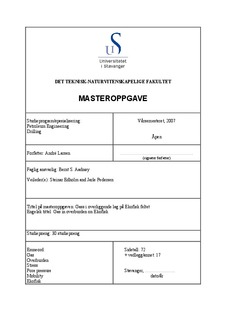| dc.contributor.author | Larsen, André | |
| dc.date.accessioned | 2008-08-12T11:38:07Z | |
| dc.date.issued | 2007 | |
| dc.identifier.uri | http://hdl.handle.net/11250/183237 | |
| dc.description | Master's thesis in Petroleum engineering | en |
| dc.description.abstract | The Ekofisk field is a large producing oil and gas field located in the southern part of the
Norwegian sector of the North Sea. The production started in 1971. During the production,
the reservoir has been decompressed due to depletion and in 1984 it was discovered that the
Ekofisk field was subsiding.
In this project, quantitative data were collected and processed to determine if there is a trend
of increasing volume of gas in overburden over a periodic time.
This paper visualizes the development of the gas in overburden over time. After
comprehensive work it seems like there is an increasing trend of more aggressive, mobile gas
in the overburden at present time compared with few years ago. This development is most
visible at the shallowest depths, especially at 3300 ft where the gas starts to enter the wells.
This development can be explained by the fact that the reservoir has been decompressed
during 30 years of production, a load the overburden could not withstand. Subsidence of the
overburden have changed both the vertical and horizontal effective stresses and a
corresponding development and change in cracks and channels can be the main factor of the
observed increasing trend of gas over time.
Gas injection on the Ekofisk field started in February 1975. The weak correlation of GOR in
some wells and the fact that five wells started to produce injected gas before the bubble point
was reached, indicate that gas channeling is a factor at Ekofisk. The gas can have migrated
upwards the formation along the casings over a geological time period.
Based the evaluation of the cuttings injection wells and the leak water injection well, 2/4-K-
22, it can be concluded that there is not a clear relationship between the injectors and the
behavior of the gas in the overburden. The SE area is the least gas bearing area even if this
area contains both a cuttings injector and the leak water injection well. The SW area seems to be the most gas bearing area after the division of the field into four areas, NE, NW, SE and SW. | en |
| dc.format.extent | 3192496 bytes | |
| dc.format.mimetype | application/pdf | |
| dc.language.iso | eng | en |
| dc.publisher | University of Stavanger, Norway | en |
| dc.relation.ispartofseries | Masteroppgave/UIS-TN-IPT/2007 | en |
| dc.subject | gas | en |
| dc.subject | overburden | en |
| dc.subject | stress | en |
| dc.subject | pore pressure | en |
| dc.subject | mobility | en |
| dc.subject | Ekofisk | en |
| dc.subject | petroleumsteknologi | |
| dc.title | Gas in overburden on Ekofisk | en |
| dc.type | Master thesis | en |
| dc.subject.nsi | VDP::Technology: 500::Rock and petroleum disciplines: 510::Petroleum engineering: 512 | en |
